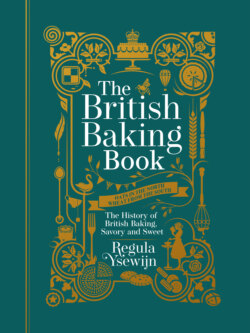Читать книгу The British Baking Book - Regula Ysewijn - Страница 23
На сайте Литреса книга снята с продажи.
ОглавлениеSavoy cake
26
For 4–6 people
4 egg yolks
4 egg whites
½ cup (100 g) superfine sugar
grated zest of 1 lemon or 1 orange
6 Tbsp (45 g) plain white flour
6 Tbsp (45 g) cornstarch
pinch of sea salt
lard, for greasing
cornstarch, for dusting
confectioners’ sugar, for dusting
For a decorative cake tin of at least 4 cups
Preheat your oven to 375°F. Grease the cake tin with lard and dust with
cornstarch, then tip out the excess cornstarch and do the same with the
confectioners’ sugar.
Beat the egg yolks in a small bowl. In a large bowl, beat the egg whites until
stiff peaks form. Gradually add the sugar, one teaspoon at a time, until the
egg whites are stiff and shiny. Add a teaspoon of the egg white mixture
to the egg yolks, add the lemon zest, and mix. Fold the egg yolks through
the egg whites.
Sift the flour and cornstarch over the mixture, add a pinch of salt, and fold in,
ensuring that the mixture is well mixed but retains its volume.
Spoon the batter into the tin and then place it in the bottom of the oven if you
are using a high mold, or in the middle if you are using a normal mold or tin.
Bake for 30–40 minutes until the top of the cake is golden brown. Let it rest
for 10 minutes in the tin and then take it out of the tin to cool on a rack.
The cake should look very pale.
Large, airy cakes such as this one were extremely difficult to make in the temperamental ovens of the 19th century.
They really tested the chef’s skill. In The Modern Baker, Confectioner and Caterer, published in 1907, author John
Kirkland said that the shape of copper Savoy cake molds was often too complicated to be practical. That’s why less
intricate copper pudding molds were often used for the Savoy cake instead.
In my National Trust Book of Puddings, I give a recipe for a tipsy pudding where this cake is made a few days ahead
and left to dry out, then soaked in sweet wine and served with custard.
Use the most beautiful, decorative tin that you have for this cake – the higher, the better – or use a Kugelhopf tin.
It’s important to follow the instructions using lard to grease the tin. When you’re using an intricate tin that doesn’t
have a non-stick coating, this method will ensure that the cake releases from the tin. Double the recipe for a larger tin.
